A cellular model to study drug-induced liver injury in nonalcoholic fatty liver disease: Application to acetaminophen
- PMID: 26739624
- PMCID: PMC4904302
- DOI: 10.1016/j.taap.2015.12.020
A cellular model to study drug-induced liver injury in nonalcoholic fatty liver disease: Application to acetaminophen
Abstract
Obesity and nonalcoholic fatty liver disease (NAFLD) can increase susceptibility to hepatotoxicity induced by some xenobiotics including drugs, but the involved mechanisms are poorly understood. For acetaminophen (APAP), a role of hepatic cytochrome P450 2E1 (CYP2E1) is suspected since the activity of this enzyme is consistently enhanced during NAFLD. The first aim of our study was to set up a cellular model of NAFLD characterized not only by triglyceride accumulation but also by higher CYP2E1 activity. To this end, human HepaRG cells were incubated for one week with stearic acid or oleic acid, in the presence of different concentrations of insulin. Although cellular triglycerides and the expression of lipid-responsive genes were similar with both fatty acids, CYP2E1 activity was significantly increased only by stearic acid. CYP2E1 activity was reduced by insulin and this effect was reproduced in cultured primary human hepatocytes. Next, APAP cytotoxicity was assessed in HepaRG cells with or without lipid accretion and CYP2E1 induction. Experiments with a large range of APAP concentrations showed that the loss of ATP and glutathione was almost always greater in the presence of stearic acid. In cells pretreated with the CYP2E1 inhibitor chlormethiazole, recovery of ATP was significantly higher in the presence of stearate with low (2.5mM) or high (20mM) concentrations of APAP. Levels of APAP-glucuronide were significantly enhanced by insulin. Hence, HepaRG cells can be used as a valuable model of NAFLD to unveil important metabolic and hormonal factors which can increase susceptibility to drug-induced hepatotoxicity.
Keywords: Acetaminophen; CYP2E1; Hepatotoxicity; Liver; NAFLD; Obesity.
Copyright © 2015 Elsevier Inc. All rights reserved.
Conflict of interest statement
Anaïs Michaut, Dounia Le Guillou, Caroline Moreau, Simon Bucher, Mitchell McGill, Sophie Martinais, Thomas Gicquel, Isabelle Morel and Marie-Anne Robin have nothing to disclose.
Figures
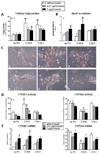
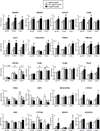
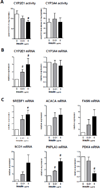

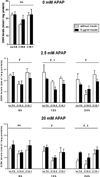
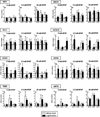
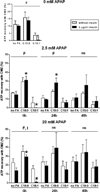
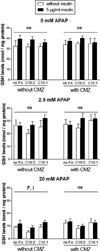
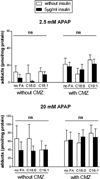

References
-
- Andersson TB, Kanebratt KP, Kenna JG. The HepaRG cell line: a unique in vitro tool for understanding drug metabolism and toxicology in human. Expert Opin Drug Metab Toxicol. 2012;8:909–920. - PubMed
-
- Aninat C, Piton A, Glaise D, Le Charpentier T, Langouët S, Morel F, Guguen-Guillouzo C, Guillouzo A. Expression of cytochromes P450, conjugating enzymes and nuclear receptors in human hepatoma HepaRG cells. Drug Metab. Dispos. 2006;34:75–83. - PubMed
-
- Anthérieu S, Chesné C, Li R, Camus S, Lahoz A, Picazo L, Turpeinen M, Tolonen A, Uusitalo J, Guguen-Guillouzo C, Guillouzo A. Stable expression, activity, and inducibility of cytochromes P450 in differentiated HepaRG cells. Drug Metab. Dispos. 2010;38:516–525. - PubMed
-
- Anthérieu S, Rogue A, Fromenty B, Guillouzo A, Robin MA. Induction of vesicular steatosis by amiodarone and tetracycline is associated with up-regulation of lipogenic genes in HepaRG cells. Hepatology. 2011;53:1895–1905. - PubMed
-
- Anthérieu S, Chesné C, Li R, Guguen-Guillouzo C, Guillouzo A. Optimization of the HepaRG cell model for drug metabolism and toxicity studies. Toxicol. In Vitro. 2012;26:1278–1285. - PubMed
Publication types
MeSH terms
Substances
Grants and funding
LinkOut - more resources
Full Text Sources
Other Literature Sources
Medical

